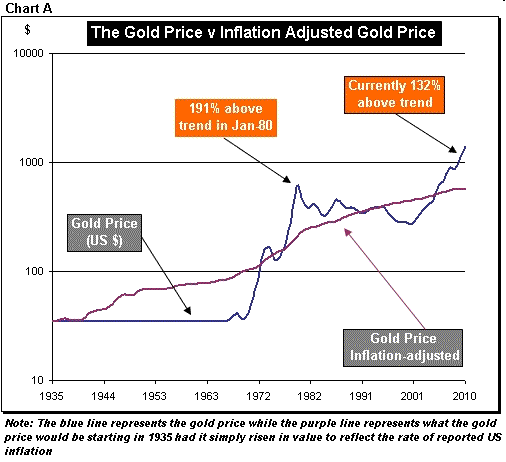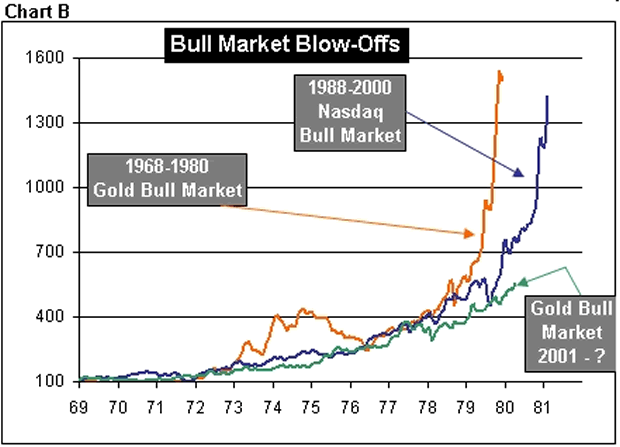The Gold Bull Market – Two out of Three Ain’t Bad
Commodities / Gold and Silver 2011 Jan 07, 2011 - 07:41 AM GMTBy: Rory_Gillen
 The gold bull market, which started from a low of $255 an ounce in early 2001, looks as strong as ever after hitting a new high price of $1,420 an ounce in late December last. In the initial years, gold’s rise had more to do with it being a cheap asset following a 20-year bear market through the 1980s and 1990s. More lately, its strength reflects deep-seated investor concerns regarding ongoing global monetary instability which has been created by persistent global trade imbalances, quantitative easing and the intervention by central banks to weaken their own currencies, of which Japan is the latest example.
The gold bull market, which started from a low of $255 an ounce in early 2001, looks as strong as ever after hitting a new high price of $1,420 an ounce in late December last. In the initial years, gold’s rise had more to do with it being a cheap asset following a 20-year bear market through the 1980s and 1990s. More lately, its strength reflects deep-seated investor concerns regarding ongoing global monetary instability which has been created by persistent global trade imbalances, quantitative easing and the intervention by central banks to weaken their own currencies, of which Japan is the latest example.
Gold’s Physical Attributes are Remarkable
While the gold bull market is all about gold’s superior monetary attributes compared to paper currencies, a reminder of gold’s remarkable physical attributes can help us understand why gold came to be a currency in the first place thousands of years ago.
Gold is the heaviest metal (highest density), it is virtually indestructible and its melting point is 1064 degrees Celsius. It is the most stretchable pure metal known to man - a single gram can be crafted into a sheet one metre squared, which is so thin that the sun can shine through. It does not oxidise (rust) in air or water, it has no taste in its purest form and it is an excellent conductor of electricity. Its physical beauty has seen it used as jewellery for thousands of years. In addition, its robustness and dependability has seen it in increasing demand in many new complex industrial applications where price is less of a consideration.
In geological terms, gold bearing rock is very rare and even when it is discovered an average tonne of gold ore yields only 6 grams of gold. That is six parts to a million. Its durability, rarity and divisibility make it valuable and tradable and allow significant wealth to be stored or transported with relative ease. It is easy to understand, therefore, how gold has been an accepted form of money for thousands of years. In contrast, paper currencies are liabilities – they represent promises by government to make good on the debt behind the currency.
The Demand / Supply Profile of Gold is Highly Favourable
The principle areas of gold supply are mine production, recycled jewellery & industrial gold and intermittent central bank selling of gold reserves. Mine production provides the biggest source of annual gold supply. But existing production supplies obviously have a finite life and exploration activity for new mines has become an increasingly difficult task even with the advances in technology. The bottom line is that gold production from mines globally is declining.
The higher gold price has increased the supply of recycled gold, a trend that should continue for several years yet.
But the supply from central bank selling, which was a feature through the late 1980s and up until recently, has reversed and central banks are now net buyers of gold for the first time in 21 years. Indeed, a fall out from the global credit crisis in 2007-08 is that central banks are now even more aware of gold’s attractions as a financial reserve. From being the sellers near the bottom of the bear market in 1999-2001, central banks globally are now net buyers after a four-fold rise in the gold price!
The annual demand for gold has been rising and the trend looks sustainable. The largest source of annual gold demand has traditionally been from jewellery & industrial usage. With the global economic downturn and higher gold price, demand from this area has fallen significantly in the past few years.
But investment demand has more than made up the gap, although clearly investment demand can be more fickle. As I outlined at the start of the article, the strength in investment demand is being driven by a number of factors;
- deep-seated investor concerns regarding ongoing global monetary instability created by persistent global trade imbalances
- ongoing quantitative easing which expands a central bank’s balance sheet and could lead to money printing eventually and
- the intervention by central banks to weaken their own currencies, of which Japan is the latest example
All of these activities have a common thread – they add to the borrowing load of nations and to the supply of money in circulation globally and have left real interest rates (the cost of money after inflation) negative for a considerable period.
In a low to negative real interest rate environment, it costs investors little or nothing to hold gold – which is significant to the extent that gold yields no income. Of course, gold does not have to offer a yield as there is no debt behind gold and so there is no risk of the asset going bust.
Global trade imbalances add to money supplies. For example, the US imports too much, pays for these imports in dollars. China, on the other hand, exports to the US for which it receives dollars. Instead of converting those dollars back into renminbi, the Chinese central bank builds dollar reserves and invests those reserves back into dollar assets, principally short dated US treasuries. Hence, too many dollars end up in the global financial system all looking for a home. Instead of a strongly rising Chinese currency, which would start to correct the trade imbalance with the US, we have the competitive devaluation of the renminbi. The consequence is that China has been assisting the US to fund its trade imbalance at interest rates far below what they should have been for as far back as 2001. And most of Far East Asia is at the same game. In Europe, Germany has been the exporter and has funded the Euro-zone periphery countries at interest rates that were too low – and we now have the Euro-zone bank and bond market crisis.
Increasing national debt loads is the most significant threat and investors know only too well that central bank money printing is the age old solution to debt constraints. Using the analogy of a company - if you have a choice to invest in either Company A or Company B, and Company B is heading towards bankruptcy then there is no price too high you could pay for Company A relative to Company B in your quest to preserve capital. Quite simply, investors fear for the solvency of several countries and know that money printing is the most likely answer. With that threat hanging over the dollar, sterling, yen and the Euro and the Chinese Renminbi shadowing the dollar, gold, as a hard currency that cannot be increased at will and which has no debt against it, has rightly reclaimed its 2,000-year old position as the currency of choice.
Nonetheless, an investor should never pay too much attention to the demand / supply arguments as a justification for any asset price - and gold is no different. Gold maintains its purchasing power against inflation in the long term and, in that respect, the current gold price (see Chart A) is already well ahead of the long term inflationary trend by my (admittedly rough) estimates. Gold’s possible overvaluation throws a major spanner in the gold bull market hypothesis.

That said, those who claim that gold is a bubble have a hard time justifying the enclosed Chart B, which shows what real bubbles in liquid assets are like and how they end. The chart depicts the 12-year gold bull market of 1968 - 1980 and the 12-year technology bull market as represented by the progress of the US Nasdaq Index from 1988 – 2000. Both bull markets experienced near parabolic price rises in their final stages before entering long term bear markets thereafter.

In comparison, this current gold bull market, which started in 2001 (in green on the chart), shows no signs of the irrational exuberance that is normally typified by rampant retail investor demand near the end. By no stretch can we argue that this gold bull market has the characteristics of a bubble.
We are, therefore, confronted with three relevant facts - interpreting them is the hard part. The first fact is that investment demand, driven by the desire to preserve capital and central bank buying, is likely to remain strong - a huge positive on the demand side. The second point is that demand for gold has been steady, quiet and patient, and not irrational. And the third point is that relative to reported inflation the gold price could already be overvalued.
But as the song goes ‘two out of three ain't bad’. My own view is that you can't price an asset (or currency) when the very solvency of the alternative asset is in doubt and I would stay aboard this gold bull market to see where it goes. But we are in dangerous territory and it would be well to recognise that a strong rise in the gold price from here is more likely to signal the end than any new beginning in this gold bull market.
Rory Gillen
Founder
www.investRcentre.com
Rory Gillen is a qualified Chartered Accountant, a former equity analyst, stockbroker and fund manager who has spent over twenty years working in the financial services industry. He founded The InvestR Centre in 2005 as a stock market training company. www.investrcentre.com
© 2010 Copyright Rory Gillen - All Rights Reserved Disclaimer: The above is a matter of opinion provided for general information purposes only and is not intended as investment advice. Information and analysis above are derived from sources and utilising methods believed to be reliable, but we cannot accept responsibility for any losses you may incur as a result of this analysis. Individuals should consult with their personal financial advisors.
© 2005-2022 http://www.MarketOracle.co.uk - The Market Oracle is a FREE Daily Financial Markets Analysis & Forecasting online publication.



